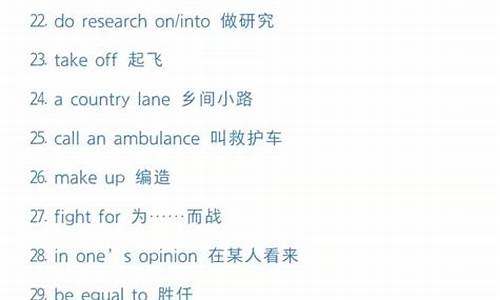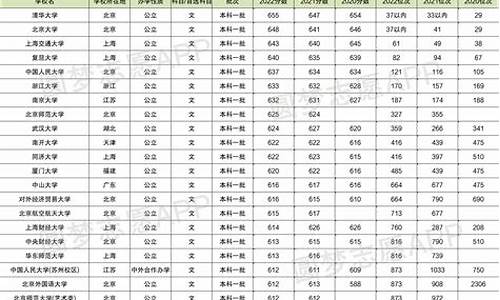您现在的位置是: 首页 > 教育新闻 教育新闻
英语高考短语,英语高考短语汇总
tamoadmin 2024-05-22 人已围观
简介1.高考英语知识点考点总结归纳 高考英语高频词组大全 1.able 用法:be able to do Note: 反义词unable表示不能,而disabled表示残疾的。 be able to do可以表示经过艰难困苦才能做到的事。 2.abroad 用法:表示到(在)国外,是一个副词,前面不加介词。 Note: 可以说from abroad, 表示从国外回来。 3.adm
1.高考英语知识点考点总结归纳

高考英语高频词组大全
1.able 用法:be able to do
Note: 反义词unable表示不能,而disabled表示残疾的。
be able to do可以表示经过艰难困苦才能做到的事。
2.abroad 用法:表示到(在)国外,是一个副词,前面不加介词。
Note: 可以说from abroad, 表示从国外回来。
3.admit 用法:表示承认的时候后面要加上动名词形式。
Note: 表示允许进入的时候与介词to搭配。
4.advise 用法:advise sb. to do; advise doing
Note: 后面的.宾语从句要用虚拟语气。即:advise that sb. (should) do的形式。
5.afford 用法:通常与动词不定式搭配使用。
Note: 前面需要有be able to或can等词。
6.after 用法:表示在时间、空间之后;be after表示追寻。
Note: 用在将来时的时候后面接一时间点,而in接一个时间段,如:after 3 o’clock; in 3 days.
7.agree 用法:与介词on, to, with及动词不定式搭配。
Note: agree on表示达成一致;agree to表示批准;agree with表示同意某人说的话。
agree vi.同意;持相同意见 I cannot agree with you on this point.在这一点上,我不能同意你的意见。
sb. agree with sb 同意某人的话,意见
sth. agree with sb 某物,某事适应某人
agree to sb 建议
agree on sth 在某一点上取得一致意见
agree up sth 在某一点上取得一致意见
agree to do sth 同意干某事
8.alive 用法:表语性形容词,在句中只能作表语,不能作定语。
Note: 可以作状语使用,表示活活地,如:bury sb. alive.
9.allow 用法:allow doing; allow sb. to do
Note: 可以表示允许进入,如:Please allow me in.
10.among 用法:用在三者或三者以上的群体中。
Note: 还可以表示其中之一,如:He is among the best.
11.and 用法:用于连接两个词、短语、句子或其他相同结构。
Note: 与祈使句搭配时往往可以表示条件。如:Work hard, and you’ll succeed sooner or later.
12.another 用法:表示又一个,泛指,相当于one more的含义。
Note: 不能直接加复数名词,需要与一个数词搭配,如:another 2 weeks.
13.answer 用法:及物动词,但在作名词时要与介词to搭配。
Note: 可以表示接电话、应门等。如:answer the phone/door.
14.anxious 用法:be anxious for/about/to do
Note: be anxious about表示担心;be anxious for表示盼望得到。
15.appear 用法:不及物动词,没有宾语,没有被动语态。
Note: 还可以作为系动词,与seem同义,表示看起来……。
16.arrive 用法:arrive at表示到一个小地方;arrive in表示到一个大地方。
Note: 引申含义表示得出,如:arrive at a decision/conclusion.
17.ask 用法:ask to do; ask sb. to do; ask for
Note: 后面的宾语从句要用虚拟语气。即:ask that sb. (should) do的形式。
18.asleep 用法:表语性形容词,在句中只能作表语,不能作定语。
Note: 通常与动词be及fall搭配;sound asleep表示熟睡。
19.attend 用法:表示参加,后面经常加上meeting, lecture, conference, class, school, wedding, funeral等词;也可以表示照顾,照料。
Note: attend to可以表示处理、照料等。
20.attention 用法:pay attention to; draw/catch sb’s attention
Note: 写通知时的常用语:May I have your attention, please?
高考英语知识点考点总结归纳
高考常用固定搭配总结
一、接不定式(而不接动名词)作宾语的24个常用动词
afford to do sth. 负担得起做某事
agree to do sth. 同意做某事
arrange to do sth.安排做某事
ask to do sth. 要求做某事
beg to do sth. 请求做某事
care to do sth. 想要做某事
choose to do sth. 决定做某事
decide to do sth. 决定做某事
demand to do sth. 要求做某事
determine to do sth. 决心做某事
expect to do sth. 期待做某事
fear to do sth. 害怕做某事
help to do sth. 帮助做某事
hope to do sth. 希望做某事
learn to do sth. 学习做某事
manage to do sth. 设法做某事
offer to do sth. 主动提出做某事
plan to do sth. 计划做某事
prepare to do sth. 准备做某事
pretend to do sth. 假装做某事
promise to do sth. 答应做某事
refuse to do sth. 拒绝做某事
want to do sth. 想要做某事
wish to do sth. 希望做某事
注:有些不及物动词后习惯上也接不定式,不接动名词:
aim to do sth. 打算做某事
fail to do sth. 未能做某事
long to do sth. 渴望做某事
happen to do sth. 碰巧做某事
hesitate to do sth. 犹豫做某事
struggle to do sth. 努力做某事
二、接不定式作宾补的36个常用动词
advise sb. to do sth. 建议某人做某事
allow sb. to do sth. 允许某人做某事
ask sb. to do sth.请(叫)某人做某事
bear sb. to do sth.忍受某人做某事
beg sb. to do sth. 请求某人做某事
cause sb. to do sth. 导致某人做某事
command sb. to do sth. 命令某人做某事
drive sb. to do sth .驱使某人做某事
elect sb. to do sth. 选举某人做某事
encourage sb. to do sth. 鼓励某人做某事
expect sb. to do sth. 期望某人做某事
forbid sb. to do sth. 禁止某人做某事
force sb. to do sth. 强迫某人做某事
get sb. to do sth. 使(要)某人做某事
hate sb. to do sth. 讨厌某人做某事
help sb. to do sth. 帮助某人做某事
intend sb. to do sth. 打算要某人做某事
invite sb. to do sth. 邀请某人做某事
leave sb. to do sth. 留下某人做某事
like sb. to do sth. 喜欢某人做某事
mean sb. to do sth. 打算要某人做某事
need sb. to do sth. 需要某人做某事
oblige sb. to do sth. 迫使某人做某事
order sb. to do sth. 命令某人做某事
permit sb. to do sth. 允许某人做某事
persuade sb. to do sth. 说服某人做某事
prefer sb. to do sth. 宁愿某人做某事
request sb. to do sth. 要求某人做某事
remind sb. to do sth. 提醒某人做某事
teach sb. to do sth .教某人做某事
tell sb. to do sth. 告诉某人做某事
train sb. to do sth. 训练某人做某事
trouble sb. to do sth. 麻烦某人做某事
want sb. to do sth. 想要某人做某事
warn sb. to do sth. 警告某人做某事
wish sb. to do sth. 希望某人做某事
注:不要受汉语意思的影响而误用以下动词句型:
汉语说:“害怕某人做某事”,但英语不说fear sb. to do sth.。
汉语说:“原谅某人做某事”,但英语不说excuse [forgive] sb. to do sth.。
汉语说:“拒绝某人做某事”,但英语不说refuse sb. to do sth.。
汉语说:“惩罚某人做某事”,但英语不说punish sb. to do sth.。
汉语说:“建议某人做某事”,但英语不说suggest [propose] sb. to do sth.。
汉语说:“赞成某人做某事”,但英语不说approve sb. to do sth.。
汉语说:“通知某人做某事”,但英语不说inform sb. to do sth.。
汉语说:“欢迎某人做某事”,但英语不说welcome sb. to do sth.。
汉语说:“坚持某人做某事”,但英语不说insist [persist] sb. to do sth.。
汉语说:“希望某人做某事”,但英语不说hope sb. to do sth.。
汉语说:“安排某人做某事”,但英语不说arrange sb. to do sth.。
汉语说:“要求某人做某事”,但英语不说demand sb. to do sth.。
汉语说:“感谢某人做某事”,但英语不说thank sb. to do sth.。
汉语说:“祝贺某人做某事”,但英语不说congratulate sb. to do sth.。
汉语说:“阻止某人做某事”,但英语不说prevent sb. to do sth.。
要表示以上意思,可换用其他表达:
汉语的“原谅某人做某事”,英语可说成excuse [forgive] sb. for doing sth.。
汉语的“希望某人做某事”,英语可说成wish sb. to do sth.。
汉语的“建议某人做某事”,英语可说成advise sb. to do sth.。
汉语的“安排某人做某事”,英语可说成arrange for sb. to do sth.。
汉语的“要求某人做某事”,英语可说成demand of sb. to do sth.。
汉语的“感谢某人做某事”,英语可说成thank sb. for doing sth.。
汉语的“祝贺某人做某事”,英语可说成congratulate sb. on doing sth.。
汉语的“阻止某人做某事”,英语可说成prevent sb. from doing sth.。
三、接动名词(不接不定式)作宾语的34个常用动词
admit doing sth. 承认做某事 advise doing sth. 建议做某事
allow doing sth. 允许做某事 appreciate doing sth. 感激做某事
avoid doing sth. 避免做某事 consider doing sth. 考虑做某事
delay doing sth. 推迟做某事 deny doing sth. 否认做某事
discuss doing sth. 讨论做某事 dislike doing sth. 不喜欢做某事
enjoy doing sth. 喜爱做某事 escape doing sth. 逃脱做某事
excuse doing sth. 原谅做某事 fancy doing sth. 设想做某事
finish doing sth. 完成做某事 forbid doing sth. 禁止做某事
forgive doing sth. 原谅做某事 give up doing sth. 放弃做某事
imagine doing sth. 想象做某事 keep doing sth. 保持做某事
mention doing sth. 提及做某事 mind doing sth. 介意做某事
miss doing sth. 错过做某事 pardon doing sth. 原谅做某事
permit doing sth. 允许做某事 practice doing sth. 练习做某事
prevent doing sth. 阻止做某事 prohibit doing sth. 禁止做某事
put off doing sth. 推迟做某事 report doing sth. 报告做某事
risk doing sth. 冒险做某事 stop doing sth. 停止做某事
suggest doing sth. 建议做某事 understand doing sth. 理解做某事
四、接现在分词作宾补的20个常用动词
bring sb. doing sth.引起某人做某事 catch sb. doing sth. 碰上(撞上)某人做某事
discover sb. doing sth. 发现某人做某事 feel sb. doing sth. 感觉某人做某事
find sb. doing sth. 碰上(撞上)某人做某事 get sb. doing sth. 使某人做某事
have sb. doing sth. 使某人做某事 hear sb. doing sth. 听见某人做某事
keep sb. doing sth. 使某人不停地做某事 listen to sb. doing sth. 听某人做某事
look at sb. doing sth. 看着某人做某事 notice sb. doing sth. 注意到某人做某事
observe sb. doing sth. 观察某人做某事 prevent sb. doing sth. 阻止某人做某事
see sb. doing sth. 看见某人做某事 send sb. doing sth.使某人(突然)做某事
set sb. doing sth. 使(引起)某人做某事 start sb. doing sth. 使某人开始做某事
stop sb. doing sth. 阻止某人做某事 watch sb. doing sth. 观五、接动词原形作宾补的11个常用动词
feel sb. do sth. 感觉某人做某事 have sb. do sth. 使某人做某事
hear sb. do sth. 听见某人做某事 let sb. do sth.让某人做某事
listen to sb. do sth. 听着某人做某事 look at sb. do sth. 看着某人做某事
make sb. do sth. 使某人做某事 notice sb. do sth. 注意某人做某事
observe sb. do sth. 观察某人做某事 see sb. do sth. 看见某人做某事
watch sb. do sth. 观察某人做某事
察某人做某事
六、接不定式或动名词作宾语意思相同的12个动词
like to do sth / like doing sth. 喜欢做某事
love to do sth / love doing sth. 喜欢做某事
hate to do sth / hate doing sth. 憎恨做某事
prefer to do sth / prefer doing sth. 宁可做某事
begin to do sth / begin doing sth. 开始做某事
start to do sth / start doing sth. 开始做某事
continue to do sth / continue doing sth. 继续做某事
can’t bear to do sth / can’t bear doing sth. 不能忍受做某事
bother to do sth / bother doing sth. 麻烦做某事
intend to do sth / intend doing sth.想要做某事
attempt to do sth / attempt doing sth. 试图做某事
高考正在紧张的备考阶段,高考英语的学习依然至关重要,不仅靠知识的积累和运用。接下来是我为大家整理的高考英语知识点考点 总结 归纳,希望大家喜欢!
高考英语知识点考点总结归纳一
高中英语实用常考 短语
首先,尤其重要的,最重要的 above all
偶然,无意中 by accident
对(于)…很积极 be active in
合计为 add up to
承让错误 admit one’s mistake
接受某人的建议 take / follow one’s advice
就…提出建议 give advice on
建议某人做某事 advice sb. to do sth.
后天 the day after tomorrow
毕竟;终究 after all
违心 against one’s will
在…岁时 at the age of
实现目标 achieve one’s aim
在空中;悬而未决 in the air
在户外,在露天里 in the open air
在机场 at the airport
火警 the fire alarm
满腔怒火 be filled with anger
因某人之言行而生气 be angry at sth.
生某人的气 be angry with sb.
通知 make an announcement
相继地,按顺序地 one after another
相互,彼此(三者或三者以上之间)one another
相互(指两者之间) each other
没有回答 give no answer
2.考试必备重点单词短语
形成…局面;产生 come into being
安全带 a safety belt
三思而后行。 Second thoughts are best.
尽力,尽最大的努力 do / try one’s best
尽量利用,善用 make the best of
一切顺利,万事如意 all the best
黑体地,粗体地 in bold
出身于农民家庭 be born in a peasant’s family
鞠躬 make a bow
动动脑子 use one’s brains
打破纪录 break the record
深吸一口气 take a deep breath
屏息;憋住气 hold one’s breath
上气不接下气 out of breath
刷牙 brush one’s teeth
突然哭起来 burst into tears
突然一阵大笑 a burst of laughter
要不是 but for
呼救声 a call for help
保持镇静(别慌) keep calm
保持安静(别吵) keep quiet
保持不动(别动) keep still
保持沉默(别说话) keep silent
夏令营 a summer camp
去 野营 go camping
情不自禁… cannot help doing
打牌 play cards
照顾,保管 take care of
医疗护理 medical care
anything but 一点也不
anything like 像……那样的东西
anywhere near 接近于
apart form 除……之外尚有
apply to 向……申请,适用于
appreciation of 对……的欣赏
argue against 反对
as a result of 作为……的结果,由于
高考英语知识点考点总结归纳二
感叹句
感叹句:一般是用来表示说话时的喜悦、惊讶等情感。英语感叹句常用"what"和"how"引导,"what"和"how"与所修饰的词置于句首, 其它 部分用陈述句语序。
感叹词 修饰对象 感叹部分 主语 谓语+其他!
How(副词) 修饰形容词 How nice
How nice a girl the girl
she is!
is!
修饰副词 How well
How hard the boy
the workers Is swimming!
are working!
修饰动词 How
=what the flowers
How
=how fast She
she
he
he Loves the flowers!
loves!
runs!
runs!
What(形容词) 修饰单数可数名词 What a nice girl
=How nice a girl Jenny
Jenny Was!
was!
修饰复数可数名词 What nice girls They Were!
修饰不可数名词 What fine weather
what dirty water It
he Is!
drank!
感叹句的特殊形式
感叹句还可由陈述句、疑问句、祈使句,甚至一个词组及单词构成。例如: There was no face showing!
He’s such a nice boy!
The Great Wall is a magnificent building!
Isn’t it snowing heavily!
Wonderful!
Nonsense!
Happy New Year to you!
Cheer!
高考英语知识点考点总结归纳三
强调句
1.强调句型用于强调陈述句;
2.强调句型用于强调一般疑问句;
3.强调句型用于强调特殊疑问句;
4.强调句型用于强调not…until…句型;
5.强调句型与状语从句、定语从句、祈使句的混合考查。
替代
1.do/does/did替代动词;
2.so和not分别代替肯定和否定的从句.
省略
1.主语的省略;
2.谓语或谓语的一部分的省略;
3.宾语的省略;
4.不定式的省略;
5.宾语从句和状语从句中的省略;
6.虚拟条件句中if的省略。
倒装句
1.部分倒装;
2.完全倒装
3.常考的几个重要句型:
So +be/情态/助动词+主语
Neither+be/情态/助动词+主语
So +adj/adv …+that …
Neither …, nor …
Not only …, but also …
Not until …
高考英语知识点考点总结归纳四
祈使句
一. 祈使句的句式特征
祈使句常常是表达说话人对对方的劝告、叮嘱、请求或命令等。因此,祈使句中一般没有主语,但根据其句意,实际上是省略了主语you。祈使句句末用感叹号或句号,朗读时,常用降调。在表达请求或劝告时,在祈使句前或句末可加, 上please,以使句, 子的语气更加缓和, 或客气。祈使句一般没有时态的变化,也不能与情态动词连用。例如:
Keep off the grass!勿踩草地!
Put the boxes in the small room.把那些盒子放到那个小房间里。
二. 祈使句的肯定句式
祈使句的肯定句式一般分为以下三种类型:
1. 行为动词原形+其他成分。例如:
Make sentences after the model.根据例句 造句 。
2. Be动词+其他成分(形容词、名词或介词短语等)。例如:
Be careful when crossing the street.过马路时要小心。
3. Let, +宾语+动词原, 形+, 其他, 成分, 。例如:
Let him go back now.让他现在回去吧。
三. 祈使句的否定句式
祈使句的否定句式,通常情况下在句首加上Don’t或Never,一般分为以下四种类型:
1. 在祈使句的肯定句式前加Don’t,构成“Don’t+行为动词原形+其他成分”。例如:
Don’t say that again!别再那样说了!
2. 在Be动词引起的肯定祈使句前加Don’t,构成“Don’t be+其他成分(形容词、名词或介词短语等)”。例如:Don’t be careless.不要粗心。
注意:在这种句型中be不能省略;否定副词not不可置于be之后。
3. Let引起的祈使句的否定形式有两种:(1)Let开头的祈使句,如果后面跟第一、第三人称名词或代词的宾格,可在Let前加Don’t,也可在Let后宾格的名词或代词后面加not。(2)如果以Let’s开头的祈使句,必须在Let’s后加not。例如:
Don’t let me go with her tomorrow. =Let me not go with her tomorrow.
不要让我明天跟她一起去。
Let’s not tell her the truth whenever we meet her.
无论什么时候我们碰到她,都不要告诉她真相。
4. 在公共场合的 提示语 中,否定祈使句常用“No+名词/V-ing形式”结构,表示“禁止做某事”。例如:
NO PHOTOS! 禁止拍照!
四. 祈使句的反意问句
祈使句的反意疑问句须按其 句子 结构及讲话人的语气来决定其疑问部分。通常有以下三种形式:
1. 祈使句为肯定句式,其反意疑问句表示请求时,通常用will you;表示邀请、劝说时,用won’t you。例如:
Be sure to write to us, will you?你一定要给我们写信,好吗?
Come to have dinner with us this evening, won’t you?
今晚来和我们一起吃饭,好吗?
2. 祈使句为否定句式,其反意疑问句通常只用will you。例如:
Don’t smoke in the meeting room, will you?
不要在会议室抽烟,好吗?
3. Let开头的祈使句构成反意疑问句时,除Let’s用shall we外,其他均用will you。例如: Let the boy go first, will you?让个那男孩先走,好吗?
Let’s take a walk after supper, shall we?
晚饭后我们去散步,好吗?
五. 祈使句的回答
祈使句的动作通常是表示将来发生的动作,所以回答祈使句时,一般用will或won’t。在回答具有否定意义的祈使句时,要注意两点:一是“形式一致”,即Yes与will保持一致;No与won’t保持一致。二是“意思相反”,即Yes是“不”的意思;No是“是”的意思。在回答时,要注意分析上下文语境中所提供的条件。例如:
--- Don’t go out, please. It’s raining heavily outside.
请不要出去。外面雨下得很大。
---- Yes, I will. I have to meet my brother at the airport.
不行,我得去机场接我弟弟。
六. 祈使句与陈述句的并列使用
祈使句后接陈述句时,须用连接词连接。如果祈使句与陈述句表示的是一种顺承关系时,要用并列连词and来连接;如果祈使句与陈述句存在一种否定条件关系时,要用并列连词or来连接。例如: Leave it with me and I will see what I can do.
把它留给我吧,我想想有没有办法。
Hurry up, or we’ll be late.
快点,否则我们要迟到了。
七. 祈使句与条件状语从句的连用
祈使句与条件状语从句连用时,条件状语从句可置于祈使句前或后。例如:
Tell him to make a phone call to me if he comes here tomorrow.
如果他明天来这儿的话,叫他给我来个电话。
八. 祈使句的强调形式
祈使句的强调形式通常在肯定祈使句式前加上助动词Do(Do在句中无意义)。例如:
Do shut up!快住口!
九. 特殊形式的祈使句
在英语中,有些祈使句不是以动词原形来引起一个祈使句,而是以一个名词短语来充当,且后接一个带有并列连接词的分句。实际上,这个充当祈使句的名词短语相当于一个条件状语从句。例如:
More water and the young trees couldn’t have died. =If you had given them more water, the young trees couldn’t have died.
如果你给那些小树多浇点水,他们就不会死了。
十. 运用祈使句的误区
祈使句往往容易与不定式、分词或条件状语从句相混淆。在平时的练习或测试中,如果稍不留神,就会出错。因此,要认真审题,认真分析句子结构,并根据上下文语境,作出正确判断。例如:
___________ your composition carefully, some spelling mistakes can be avoided.
A. Having checkedB. Check
C. If you checkD. To check
析:如果空白处选填B(Check)项,则视为祈使句,但后一分句前没有并列连接词and连接;如选A或D项(分词或不定式),句中逻辑主语some spelling mistakes又不能执行这个动作,故均不符合句子结构。因此,只有C项(条件状语从句)符合句子结构及句意。
高考英语知识点考点总结归纳相关 文章 :
1. 高考英语知识点考点归纳
2. 高考英语知识点总结归纳
3. 高考英语知识点归纳整理
4. 英语高考知识点总结归纳
5. 高考英语知识点汇总大全
6. 高考英语知识考点汇总
7. 高考英语考点总结
8. 高考英语知识点归纳
9. 高考英语知识点总结
10. 高中英语知识点总结与归纳









